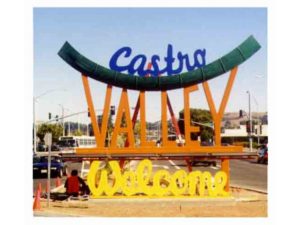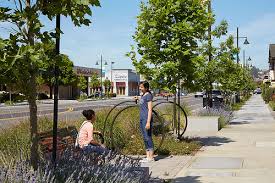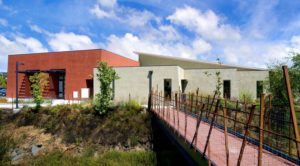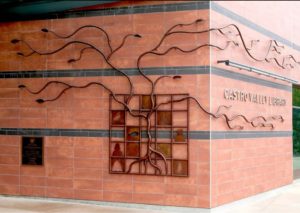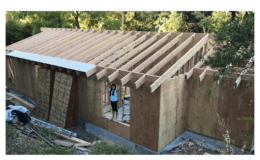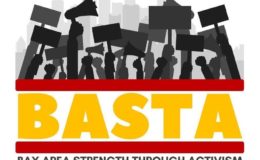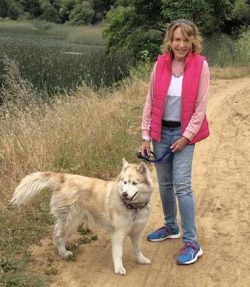Hard to believe that it’s been twenty years for thee old canoe! Is it still around. They should put it at the entrance of the BART Train tunnel!
After 20 Years, Public Art is Enjoying a Renaissance in Castro Valley
- By : Christine Tengan
- Category : Community, Featured Story, Public Art
- Tags: Placemaking, Public art

“Why Public Art Matters”
[Towns] gain value through public art – cultural, social, and economic value. Public art is a distinguishing part of our public history and our evolving culture. It reflects and reveals our society, adds meaning to our [towns] and uniqueness to our communities. Public art humanizes the built environment and invigorates public spaces. It provides an intersection between past, present and future, between disciplines, and between ideas. Public art is freely accessible.”
-AMERICANS FOR THE ARTS
PUBLIC ART NETWORK COUNCIL: GREEN PAPER
Did you live in Castro Valley 20+ years ago when the infamous “canoe” identifying sign was erected on Redwood Road and promptly removed 2 months later following loud community outcry?
It certainly was a dark time for public art in our town. Not only were many of us frustrated about the lack of input we were allowed related to a sign that was supposed to represent our community, but the artist was also treated unfairly in this unsavory episode.
Fortunately, things in the public art realm have changed a lot in 20 years. Our terrific Alameda County Arts Commission (ACAC) has overseen the addition of lovely artistic elements in Castro Valley, including the Castro Valley Boulevard Streetscape and the Library’s sculptural projects.
Artistic bike racks included in Castro Valley Blvd Streetscape
Custom iron/railcar bridge leading to the Castro Valley library
Tree of Knowledge sculpture greeting Castro Valley library patrons
A number of factors have led to these positive changes around public art in Castro Valley. Castro Valley Matters (CVM) has been working tirelessly on one of its main mission-specific goals of advocating for aesthetic improvements that beautify Castro Valley and help provide its residents a better sense of place. CVM spearheaded a successful partnership with ACAC to bring the Castro Valley Community Identifier Mural to CV, the first piece of major placemaking public art since the Streetscape project was completed in 2012.
Another major factor making public art more accessible in town is that ACAC, headed by Executive Director Rachel Osajima for the last 14 years, has approached the art selection process in a way that heavily involves input from all stakeholders, especially the community. As with other projects, the CV Municipal Advisory Committee (MAC) weighs in but what is truly making more recent artistic projects so successful is the extensive outreach by ACAC to ensure that the community’s hopes and wishes weigh heavily in all design decisions.
In 2019 Castro Valley residents will witness a true renaissance of public art in our place as the installations of some very visible and long awaited public art will finally come to fruition. The Castro Valley Community Identifier Mural, over Redwood Road at the Hwy 580 overpass, will be hand-painted by committee-selected artist Robert Minervini in the Spring. As CVM played a key role in spearheading this public art project, we’re immensely excited to see the progress!
In addition to working toward a community identifier mural at this location, CVM has been pursuing utility box art with ACAC. We’re pleased that ACAC has been very responsive and, in conjunction with the community identifier mural, ACAC will also be installing vinyl-wrap snippets of the Minervini mural on 10 utility boxes in the vicinity of the mural. The lovely images, including mountains, valleys and our iconic Lake Chabot, will be beautiful additions to our downtown.
What could prove to be even more exciting is Phase 2 of ACAC’s utility box art initiative in Castro Valley. Under this program, by late 2019 the remaining 30+ utility boxes in our town will don their own new art, commissioned from 4-8 artists selected, again, by a committee that includes town residents. The goal, according to a recent ACAC update, “is to select a group of artists who will each provide a series of designs that are related in style and theme. Each artist will be assigned approximately 5-10 boxes in the same general area … Artists may be commissioned to create new artworks, or existing artworks may be used and modified, with the artist’s approval, to suit the format of the utility box … The designs will be printed on a vinyl material which will wrap the utility boxes. Artists working in [a] wide variety of artistic styles and mediums will be considered … The licensing fee for each artwork will be $500. Artists who live, work, or rent/own a studio in Alameda County and who are currently in the Arts Commission’s Artist Registry will be considered …”
Phase 2 of the utility box art program is so exciting because it opens up the pool of artists to include the work not only of painters but of graphic artists and photographers as well. With the art being refreshed with new pieces about every 3 years, the accessibility of this innovative public art program allows art to be kept fresh and current, and the breadth of vetted artists able to share their art in the public realm to grow. And although the ACAC Artist Registry is currently closed it will open again before Phase 3 of the utility box art program in a few years. Are you a local Castro Valley artist in any medium (or know of one!) who would like the opportunity to have your work considered for this exciting public art program? Consider joining ACAC’s mailing list so you can be alerted when the artist registry reopens: Alameda County Arts Commission – Stay Connected . We would love to see more public art in Castro Valley from some of the many talented artists who call our place home!
Please also consider joining Castro Valley Matters! Our active Placemaking group is always looking for new perspectives, ideas and energy… Join Castro Valley Matters today!
~Christine Tengan, Chair, Placemaking Committee
